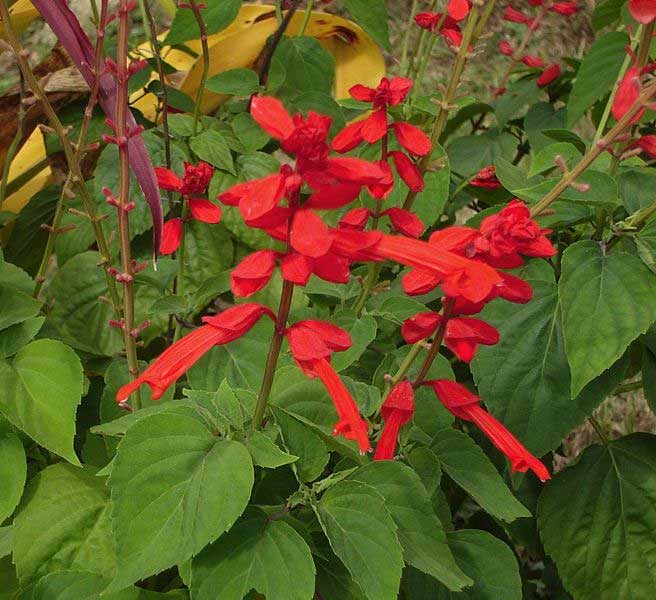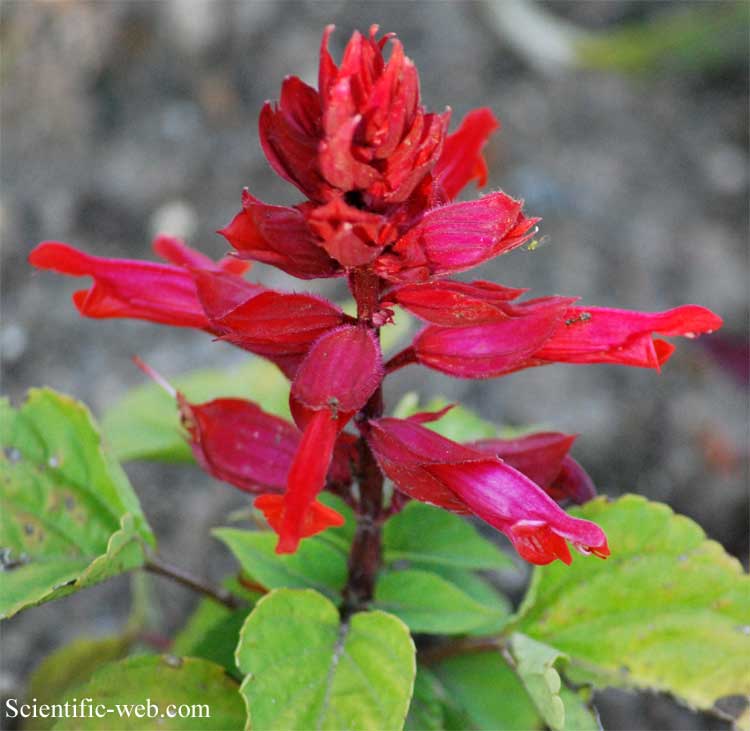
Salvia splendens (Photo: *)
Classification System: APG IV
Superregnum: Eukaryota
Regnum: Plantae
Cladus: Angiosperms
Cladus: Eudicots
Cladus: Core eudicots
Cladus: Asterids
Cladus: Lamiids
Ordo: Lamiales
Familia: Lamiaceae
Subfamilia: Nepetoideae
Tribus: Mentheae
Subtribus: Salviinae
Genus: Salvia
Subgenus: S. subg. Calosphace
Sectio: S. sect. Secundae
Species: Salvia splendens
Name
Salvia splendens Sellow ex Nees, Flora 4(1): 300–301. 1821,
Type: Brazil. Sellow s.n. (B)
Synonyms
Homotypic
Fenixanthes splendens (Sellow ex Nees) Raf., Autik. Bot. 122. 1840.
Jungia splendens (Sellow ex Nees) Soják, Čas. Nár. Muz. Praze, Rada Přír. 152(1): 21. 1983.
Salvia splendens Sellow ex Wied-Neuw., Reise Bras. 1: 46. 1820, nom. inval.
Salvia splendens Sellow ex Schult, Mantissa 1: 185. 1822, nom. superfl.
Salvia splendens Sellow ex Ker Gawl., Bot. Reg. 8: t. 687. 1823 [1], nom. superfl.
Heterotypic
Salvia brasiliensis Spreng., Syst. Veg. 1: 56. 1824.
Salvia colorans Benth., Labiat. Gen. Spec.: 287. 1833, nom. inval.
Salvia issanchou auct., Rev. Hort. (Paris) 62: 229. 1890.
Salvia splendens var. atropurpurea hort.
Salvia vanhouttei hort.
Hybrids
S. × rociana
Distribution
Native distribution areas:
Continental: Southern America
Regional: Brazil
Brazil Southeast
Introduced into:
Argentina Northeast, Argentina Northwest, Bangladesh, Brazil South, Bulgaria, Cayman Is., Colombia, Comoros, Costa Rica, Cuba, Czechoslovakia, El Salvador, Fiji, Florida, Guatemala, Gulf of Guinea Is., Honduras, India, Jamaica, Jawa, Korea, Mexico Southeast, Nicaragua, Peru, Puerto Rico, Romania, Trinidad-Tobago, Ukraine, Venezuela, Venezuelan Antilles, Wisconsin

Salvia splendens, 'Salsa Burgundy' , Photo: Michael Lahanas
References: Brummitt, R.K. 2001. TDWG – World Geographical Scheme for Recording Plant Distributions, 2nd Edition
References
Primary references
Sellow, F., 1821. Flora 4(1): 300–301.
Additional references
Govaerts, R.H.A. 2003. World Checklist of Selected Plant Families Database in ACCESS: 1-216203. The Board of Trustees of the Royal Botanic Gardens, Kew. [unavailable for the public] Reference page.
Nees von Esenbeck, C.G.D. (1821) Flora 4(1): 300–301.
Links
Govaerts, R. et al. 2022. Salvia splendens in World Checklist of Selected Plant Families. The Board of Trustees of the Royal Botanic Gardens, Kew. Published online. Accessed: 2022 May 16. Reference page.
Hassler, M. 2022. Salvia splendens. World Plants: Synonymic Checklists of the Vascular Plants of the World In: Roskovh, Y., Abucay, L., Orrell, T., Nicolson, D., Bailly, N., Kirk, P., Bourgoin, T., DeWalt, R.E., Decock, W., De Wever, A., Nieukerken, E. van, Zarucchi, J. & Penev, L., eds. 2022. Species 2000 & ITIS Catalogue of Life. Published online. Accessed: 2022 May 16. Reference page.
Tropicos.org 2022. Salvia splendens. Missouri Botanical Garden. Published online. Accessed: 16 May 2022.
International Plant Names Index. 2022. Salvia splendens. Published online. Accessed: May 16 2022.
Vernacular names
Deutsch: Feuersalbei
English: Scarlet sage
suomi: Tulisalvia
日本語: サルビア
한국어: 샐비어
Nederlands: Vuursalie
polski: Szałwia błyszcząca
lea faka-Tonga: teʻekosi sivilaise
Türkçe: Ateş çiçeği
中文: 一串红
Salvia splendens, the scarlet sage,[1] is a tender herbaceous perennial plant native to Brazil, growing at 2,000 to 3,000 m (6,600 to 9,800 ft) elevation where it is warm year-round and with high humidity. The wild form, rarely seen in cultivation, reaches 1.3 m (4.3 ft) tall. Smaller cultivars are very popular as bedding plants, seen in shopping malls and public gardens all over the world.[2][3]
Taxonomy
Salvia splendens was first described and named in 1822. At that time it was given the common name "Lee's scarlet sage". Before the plant was selected to become dwarf in size, an early Dutch selection named 'Van Houttei' was chosen and is still popular in the horticulture trade.[2]
Description
S. splendens 'Van Houttei'
The native type is rarely used or described, though it grew from 1.5 to 8 m (4.9 to 26.2 ft) in height. Its leaves are in even, elliptical arrangements, 7 × 5 cm, with dentate margin and they have long petioles. It may branched, where its upper branches are finely hairy and in the lower parts though hairless. Flowers in erect spikes that sprout from the centre of the plant in groups of 2 to 6 together in each leaf node; scarlet, tubular or bell-shaped, 35 mm long, with two lobes towards the apex; the upper lobe is 13 mm long. It flowers a good part of summer and autumn.
Exhibition of Flower Festival, Taichung, Taiwan
Cultivation
It is widely grown as an ornamental plant, with a large number of cultivars selected by different colours from white to dark purple. It is a subtropical species that does not survive freezing temperatures, but can grow in cold climates as an annual plant. The most common selections are the dwarf sizes that go by names such as 'Sizzler' and 'Salsa', and planted en masse in gardens and malls. 'Van Houttei' reaches 1 to 1.3 m (3.3 to 4.3 ft) in height. The various types typically have red flowers.[2]
Cultivars
Named cultivars include:
S. splendens 'Alba', with white flowers
'Atropurpurea', with dark violet to purple flowers
'Atrosanguinea', flowers dark red
'Bicolor', flowers white and red
'Bruantii', small, with red flowers
'Compacta', small, flowers in dense racemes, white or red
'Grandiflora', large, with large red flowers
'Issanchon', small, with white flowers striped pink to red
'Nana', an early-flowering cultivar, with red blossoms
'Scarlet Pygmy', a very dwarf, early flowering seed race with intense scarlet blossoms
'Semperflorens', continuous flowering
'Souchetii', small, with white or red flowers
'St. John's Fire', dwarf plants with dense, abundant, scarlet, early-flowering, long-lasting blossoms
'Violacea', flowers dark violet to purple.[3]
The cultivars 'Vanguard'[4] and 'Van-Houttei'[5] have gained the Royal Horticultural Society's Award of Garden Merit.[6]
References
"Salvia splendens". Germplasm Resources Information Network (GRIN). Agricultural Research Service (ARS), United States Department of Agriculture (USDA). Retrieved 6 February 2021.
Clebsch, Betsy; Barner, Carol D. (2003). The New Book of Salvias. Timber Press. pp. 278–280. ISBN 978-0-88192-560-9.
Mark Griffiths, Editor. Index of Garden Plants, 2nd American Edition. (Portland, Oregon: Timber Press, 1995. ISBN 0-88192-246-3.)
"Salvia splendens 'Vanguard'". RHS. Retrieved 5 March 2021.
"RHS Plant Selector - Salvia splendens 'Van-Houttei'". Retrieved 5 March 2021.
"AGM Plants - Ornamental" (PDF). Royal Horticultural Society. July 2017. p. 95. Retrieved 14 October 2018.
Retrieved from "http://en.wikipedia.org/"
All text is available under the terms of the GNU Free Documentation License

